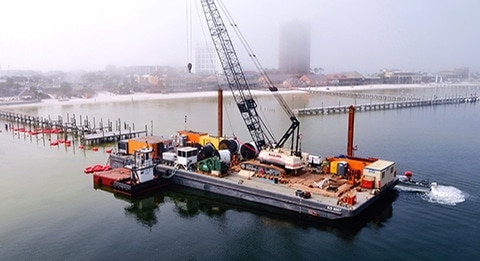
Drilling Down to the Benefits of Trenchless Technology with Jake Huber
Just two years into his career, Jake Huber has already had a lot of exposure to Horizontal Directional Drilling (HDD) projects.
HDD is just one construction method in the Trenchless Technology family of construction methods used for the installation of pipelines and cables below ground to minimize or eliminate excavation.
“Trenchless technology can provide positive social, economic, and environmental alternatives to pipeline and utility installations,” Jake said.
One such project took Jake from his Raleigh, NC office to Santa Rosa, FL, for the upgrade and replacement of four electrical power distribution subaqueous cables for Gulf Power, who required Kleinfelder’s assistance in avoiding sensitive environmental resources and streamlining permitting.
The Kleinfelder team, including Jake, provided HDD design support for the project to avoid direct and secondary impacts to approximately 2 acres of seagrass that the typical cable installation methods (via a jet plow) would have otherwise caused.
“I primarily work on the design and calculations of HDDs, and I believe each project presents a different scenario or set of risks,” Jake said. “The information and data gathered throughout the design process allows for our team to approach each drill with a specific solution in mind to conduct a successful project delivery.
To gain the best advantage of each drilling method on the Santa Rosa Sound project, Kleinfelder bored approximately 1,000 feet under existing seagrass to avoid direct and secondary impacts from cable installation. The team also pushed HDD pipe from landside in one direction to avoid seagrass and drilled from a barge to the pipe to tie in the cable.
Though this wasn’t Jake’s first HDD project, it was his first outfall project. “In short, an outfall line is a Horizontal Directional Drill that exits within a cofferdam in a body of water,” he explained. “This project was unique because it consisted of two separate drills from the shore out into cofferdams in the Santa Rosa Sound.”
What made the work more challenging was the lack of access and visibility due to the water. “The Horizontal Directional Drills used a wireline tracking system for the pilot bore, which has to be laid out, staked, and surveyed,” Jake said. “But due to the tides in the Sound, the wireline shifted throughout the drilling process and caused false directional readings for the steering hand. The soft soil conditions also made it difficult to keep a clean bore hole open for the duration of the project.”
The Kleinfelder team’s design solution considerably reduced environmental impacts, operating budget, and permitting time by avoiding near-shore seagrass impacts; excluding long- term permitting, monitoring, and mitigation; preserving more than $500,000 in capital budget through elimination of a 10-year monitoring requirement; and reducing the permitting timeline by a full year.
“Trenchless technology is important and is expanding within our industry,” Jake added. “Owners and operators of oil, gas, and water pipelines can really benefit from the technology as it can lower costs, reduce installation time, and minimize adverse impacts to the environment as well as disruptions to the public in urban settings.”
“Just remember, you don’t know what you don’t know!”
“I enjoy the niche market and unique abilities trenchless technologies bring to the oil and gas industry and the expanding uses of trenchless technology in our society.”
 Jake Huber is a Civil Engineer at Kleinfelder. He is based in Raleigh, NC.
Jake Huber is a Civil Engineer at Kleinfelder. He is based in Raleigh, NC.

